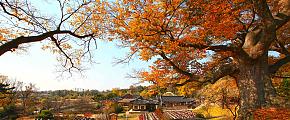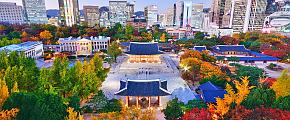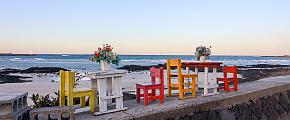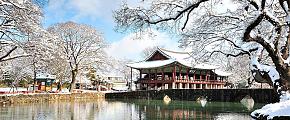Tips and Suggestions for Traveling to South Korea
South Korea is known to be one of the most desired travel destinations in Asia. With the growing influence and popularity of South Korean pop music and South Korean dramas, many people are eager to visit the place where it all started. South Korea has a lot to offer and this article will give you a glimpse of what you can experience: foods you should definitely try, sites that are a must-visit, the exquisite cafe culture, etiquette tips to look out for and Korean phrases you can learn before visiting South Korea. While it's fun to travel to a country to discover what it has to offer, it is also important to know some basic things before making your way to South Korea. This way, you can enjoy every moment you spend and relish every part of your trip.
To ease your travel experience, below are the top tips and suggestions for your South Korea tour.
Visa Requirements for Traveling to South Korea
According to the South Korean visa requirements, most European, South American, and some Middle Eastern countries are able to enjoy a South Korean visa exemption of up to 90 days. While a few Asian countries and islands across the Mediterranean enjoy a 30-day visa exemption. So check the website before your visit. However, if you are not listed under the Visa Waiver Agreement, then you require a visa to enter the country. Try to contact the South Korean embassy or consulate or visit the website where you currently reside.
Etiquette Tips: Tipping & More
Tipping
Although many countries practice a tipping culture, South Korea is an exception. Usually, a small tip of 5 - 10% is suggested in some Western-style restaurants. However, it is not customary to tip at most restaurants and cafes, which do not accept or allow tips. Sometimes insisting on tipping, although you may have good intentions, can be considered disrespectful. Therefore, try not to tip when eating out in South Korea. Instead, treat the waiters with politeness and express your appreciation for their hard work verbally. For example, say annyeonghaseyo (hello) when entering the restaurant, and when leaving, you could say Kamsahamnida (thank you).
Taking off Your Shoes
Similar to many Asian cultures, South Korea is particular about where shoes should be worn. Generally, it is considered impolite to wear shoes when inside someone's home. This rule applies to temples some restaurants that follow the traditional style of eating and so you might need to remove your shoes to enjoy your meal at the restaurant. These styles of restaurants are where you are seated on the floor to experience how locals eat. In addition, other traditional buildings you might visit during your stay in South Korea may require you to remove your shoes as well.
Clothing for Each Season
Spring
Light clothing is enough, but a jacket to take along as it can still get chilly at night.
Summer
Light clothes, sandals a light jacket, and rain boots as it is monsoon season in South Korea (light jacket for use indoors because of the air conditioning)
Autumn
Long sleeves clothing and jacket (autumn is usually warm in the afternoon and cold at night)
Winter
Long thick winter clothes, boots, scarves, gloves and innerwear, thick socks, and hats (winters are usually very cold in South Korea)
Check Out the Cafe Culture
When visiting Seoul, enjoying the South Korean cafe experience is an activity not to be missed. South Korea consumes more coffee than the global average every year, reaching a total of 353, which is 2.7 times bigger than the global average of 132 cups a year. That is because the cafes in South Korea are more than just places to enjoy coffee; they are a part of people's social lives. The uniqueness of each cafe you find on the streets of Seoul attracts customers with their specialties. Some cafes are known for their calm environment and cozy vibe. Not only do you get to savor the unique beverages, but you also try their attractive and diverse desserts, including South Korean, French, Italian, etc. You can also enjoy some cafes with amazing interiors and atmospheres, making them perfect for taking some memorable photos. Some of the cafes in South Korea have something themed; they have some kind of alluring catch to draw people in to try them out. These themed cafes can range from massage cafes offering high-end massage chairs to flower cafes dripping in plant life to pop culture-inspired cafes like the Harry Potter-themed 934 King's Cross.
Top Foods You Should Definitely Try in South Korea
South Korea is known for its exquisite cuisine. If you haven't already seen it on K-dramas, you know that there is so much to look forward to when going to South Korea. The list is endless on what you can try during your trip, but to make it a little easier, below are the top 10 staple dishes of South Korea - meaning they are a must-try.
Kimchi
Kimchi is the national food of South Korea; it is made from cabbage, radish, and spices and has a sour and tangy flavor. It is usually served as "banchan," which means a small side dish. But it can also be mixed with and added to soups and stews for an extra kick of flavor.
Kimbap
Kimbap is a South Korean seaweed rice roll. They can contain a variety of ingredients that can be used, including meat, tuna, spam, egg, vegetables, kimchi, radish, etc. Kimbap is sold nearly everywhere, so you can easily enjoy this light and scrumptious meal anywhere. Kimbap is also suitable for vegetarians, as you can get it with tofu and plenty of other vegan options.
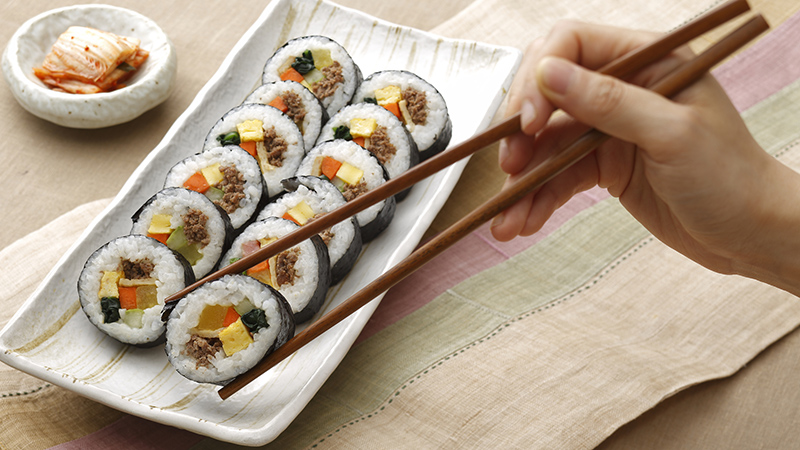 Kimbap
Kimbap
Ttebeoki
Ttebeoki is a South Korean rice cake and one of the go-to street vendors for spicy snacks in South Korea. These rice cakes are chewy and are often served with a spicy gochujang (red pepper paste) based sauce.
South Korean BBQ
South Korean BBQ is a hearty meal that South Koreans enjoy not only for its exquisite taste but also as a way to enjoy a meal with friends or family. The interesting thing about South Korean BBQ is that you eat it indoors. You are seated at a table and can choose from a variety of meats, seafood, and vegetables. In the middle of every table is a grill where you can grill your ingredients and enjoy a hot bite. You can also dip your meat in their staple sauce, ssamjang (a spicy South Korean dipping sauce).
Bibimbap
Bibimbap is a popular South Korean soul food. The idea of Bibimbap is a mixture of rice, sauteed vegetables, and a meat component (seafood or meat) and is seasoned with sesame oil, chili pepper paste, soy sauce and a fried egg on top.
 Bibimbap
Bibimbap
Bulgogi
Bulgogi - Marinated beef barbecue that is thinly sliced and is usually cooked with onions, garlic and then wrapped in lettuce. It is a popular dish mostly in the northern districts. The meat used ranges from rib eye, brisket or sirloin.
Japchae
Japchae - Stir-fried glass noodles with vegetables. The texture of the noodles is chewy and soft it is a type of thin clear noodles stir-fried with vegetables, meat, soy sauce and a bit of sugar to give it a subtle sweetness. It is usually served as a side dish or can be enjoyed on its own.
Jajangmyeon
Jajangmyeon is a fusion of South Korean and Chinese cuisine. It is a noodle dish that quite literally translates to fried sauce noodles. The noodles are usually handmade and are thick they are topped with a thick soy oyster sauce, meat or seafood and vegetables. This South Korean meal dates back decades and is a very popular everyday dish.
Ramyun
Ramyun is a South Korean instant noodle and it has made waves across the globe. Nearly everyone has heard of South Korean Ramyun. There are a variety of flavors and textures for you to try from. You can find them in any convenience store or supermarket, the best thing is you can enjoy them on the spot as most convenience stores have a place for you to prepare your noodles.
Chmaek - South Korean Fried Chicken
South Korean fired chicken is known as "Chmaek" in South Korea. This is another staple dish of the nation and it is the perfect street food. The chicken is usually marinated with different ingredients. You can try many flavors as well, from spicy to cheesy.
Greetings and Common Phrases to Learn Before Traveling to South Korea
Although you can get by with English, it's always nice to learn basic words in South Korean to show appreciation for the language and locals
Below is a list of common phrases you can use during your travel experience in South Korea
- An-nyeong ha-se-yo (안녕하세요): Hello
- Ne (네): Yes
- A-ni-yo (아니요): No
- Jeo-gi-yo (저기요): Excuse me
- Gam-sa-hab-ni-da(감사합니다): Thank you
- Eol-ma-ye-yo?(얼마예요?): How much is it?
- Mas-is-seo-yo!(맛있어요!): It's delicious
- An-nyeong-hi gye-se-yo (안녕히 계세요): Goodbye
Plan Your South Korea Tour With Odynovo
South Korea is definitely a must-go destination. Not only are you able to experience the best sites during each season, but you also have the chance to learn some culture, enjoy the beautiful scenery, the best beaches, and dive into the amazing South Korean culture. Be sure to take the tips and suggestions mentioned above into account, travel with Odynovo and enjoy South Korea to the fullest. For further information, please feel free to write to [email protected] or contact us to design your own customized itinerary.
Quick Question
Related Posts You May Like
What Our Clients Say
Explore the latest verified reviews of Odynovo's travel services on Tripadvisor, Google, Trustpilot, Product Review and more trusted platforms.
SUBSCRIBE TO WIN A FREE TOUR
Subscribe to our newsletter for a chance to win a free 7-day tour to India! And more insider travel news, exclusive offers, and inspiration will be sent straight to your inbox. Check our previous newsletters and get some sparks.


